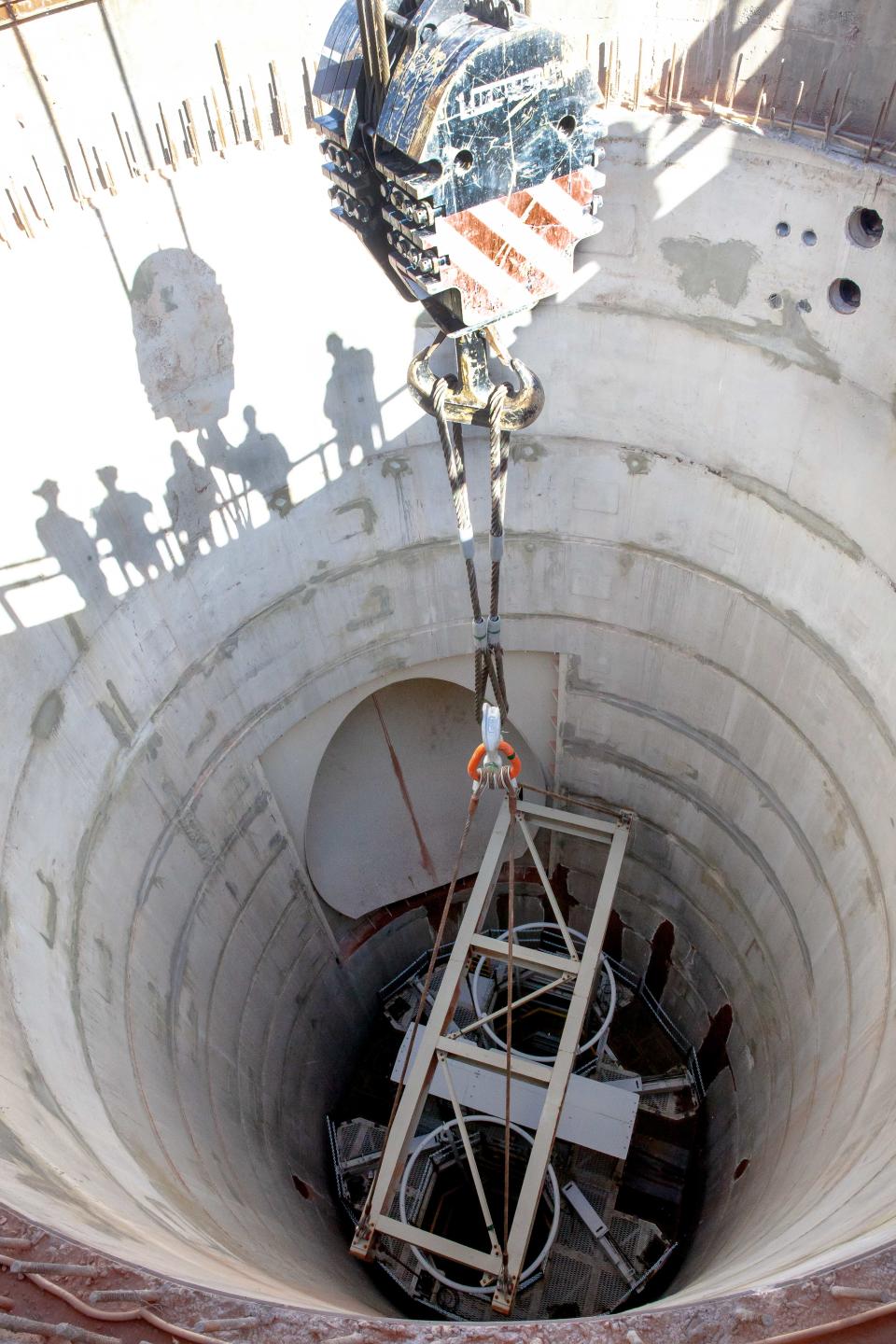Aging infrastructure could pose risks at Waste Isolation Pilot Plant nuclear waste site
An elevator used to move mined salt out of the Waste Isolation Pilot Plant drew concerns from federal oversight officials as gradually collapsing salt put excess stress on the hoist.
The salt “creep” is what gradually buries the waste disposed of at WIPP, placed in the facility after being trucked from nuclear facilities around the U.S. and emplaced in the 2,000-foot-deep salt deposit about 30 miles east of Carlsbad.
But the salt’s natural collapse also stressed the salt handling shaft to a point that left it in danger of collapse, according to the latest report from the Defense Nuclear Facilities Safety Board published Feb. 2.
More: 489 shipments of nuclear waste made its way to WIPP in 2023, breaking previous records
That report also contended WIPP’s operations contractor Salado Isolation Mining Contractors (SIMCO) had not conducted a “formal” analysis of the safety and operational impacts of taking the shaft out of service.
On Jan. 4, a preventative maintenance inspection rated the shaft as “unsatisfactory,” the report read, due to its “overstressed” condition.
“The Board’s staff remains concerned regarding the lack of formal analysis covering the nuclear safety and operational impacts if Salado Isolation Mining Contractors, LLC (SIMCO) must take the Salt Handling Shaft out of service,” read the report.
More: The WIPP facility near Carlsbad will mine new space to dispose of nuclear waste
The risks at the salt shaft were also voiced by the Board in its Jan. 5 WIPP report for activities in December 2023, which noted temporary structural repairs were used but that it lacked funding for a “permanent resolution.”
Concerns for the safety of the shaft dated back to 2017, the report read, and the Board reported WIPP’s primary contractor SIMCO was preparing a long-term fix that could involve a conveyor system to bypass the shaft.
“The Salt Handling Shaft continues to be the subject of ongoing federal and contractor evaluations regarding its structural condition and efforts required to maintain safety and operational capabilities,” read the January report.
More: Federal budget talks could endanger Holtec nuclear waste site near Carlsbad
Aside from the salt shaft, the Board noted other problems with the under-construction new utility shaft on the west end of the mine.

When complete, the $100 million project will act as an air intake shaft as part of a broader rebuild of WIPP’s ventilation system.
Late last year, a platform being used at the shaft became misaligned and fell about 2,000 feet to the bottom, an incident that led to a halt of construction at the shaft as repairs were made and a new hoisting plan was devised.
More: Why did so much of WIPP's 479 nuclear waste shipments in 2023 come from Idaho?
In the Feb. 2 report, the Board reported another problem at the utility shaft as partial work was authorized Dec. 13, 2023.
This time, about 900 feet of blast line not in use fell past a work crew about 1,950 feet down, and coiled on an unattended platform, the report read.
No injuries were reported, the report read, as the crew was working under metal overhead protection.
More: 'Partial work' resumes after cable snap shut down utility shaft project at WIPP
The partial work release was maintained, delaying most of the construction on the shaft through January, read the report.
Mark Bollinger, manager of the Department of Energy’s Carlsbad Field Office said SIMCO and its subcontractor Harrison Western Shaft Sinkers were taking a “phased approach” to resume work on the utility shaft.
“We’ve begun a detailed surface and underground inspection of the shaft and equipment. Following the inspections, any repairs that may be needed will be completed,” he said following the incident. “Full work on the Utility Shaft will resume only after any necessary corrective actions have been implemented.”
More: Nuke weapons waste disposal using Waste Isolation Pilot Plant to have 'negligible impact'
Don Hancock at the Southwest Research and Information Center argued the infrastructure issues at WIPP were due to the facility aging beyond its originally intended lifetime, since the facility was built in the 1980s and began accepting waste in 1999.
To keep waste disposal continuing for the coming decades, Hancock said WIPP’s infrastructure and equipment would need to be replaced of the federal government needs to find another location for the work.
“The facilities are at the end of that lifetime,” Hancock said. “The idea that it could operate for decades longer, just is not true.”
Adrian Hedden can be reached at 575-628-5516, achedden@currentargus.com or @AdrianHedden on the social media platform X.
This article originally appeared on Carlsbad Current-Argus: WIPP sees risks from aging facilities at nuclear waste disposal site

